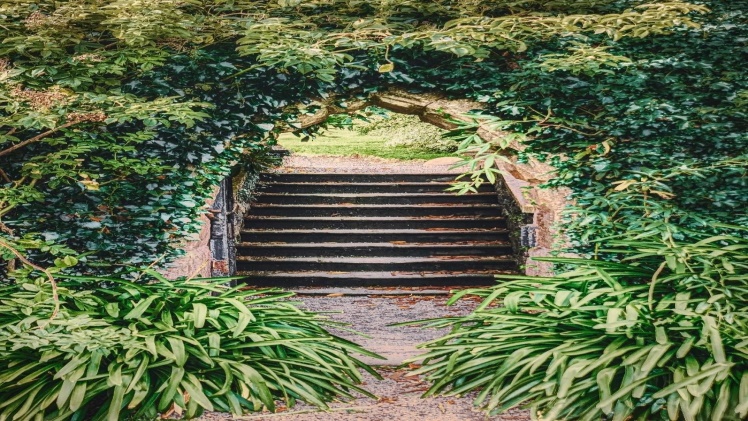Building a set of stone stairs is a great way to add an elegant and durable feature to your backyard. But with so many types of stones available, it can be challenging to choose the right one for your specific project.
This is why, in this article, we’ll provide you with five tips on how to choose the best stone for your backyard stairs. We’ll explain what to consider in terms of style, function, and more, and help you determine the best option for your project.
1. Choose a Durable Stone
When selecting the stone for your stairs, your first criterium should be its durability. Why?
Outdoor stairs are exposed to various weather conditions, foot traffic, and other factors that can cause wear and tear over time. Therefore, you need to choose a stone that can withstand these conditions and last for many years.
Natural stones like granite, quartzite, travertine, or slate are all very durable and great options for outdoor stairs. With the right maintenance, stairs made from natural stone can last for decades. They are also great for drainage because they allow water to flow over them without fear of rot.
When made strategically, they can prevent erosion and water damage, by deterring the flow of water down the sloped area.
2. Make Sure It Is Slip-Resistant
Stairs can be slippery when wet, which can pose a safety hazard, especially for children and the elderly. Therefore, it’s essential to choose a stone that has a texture that can provide good traction, even when wet.
Here is a list of some of the best slip-resistance stones for backyard stairs:
- Sandstone—it has a rough, grainy texture that prevents slipping.
- Granite—it has a coarse texture and natural slip resistance and comes in a range of colors and patterns to suit any design.
- Limestone—it is a slip-resistant stone that can give a rustic look to your stairs.
- Slate—it has a fine-grained texture and natural clefts that provide a non-slip surface.
- Quartzite—it is a dense stone with a slip-resistant surface and low water absorption, making it an excellent choice for wet areas.
3. Consider Stone Shape and Size
Stones come in various shapes and sizes, and you should think about what shape and size will work best for your project. In other words, the material you choose for your backyard stone stairs will also affect the shape and size of your stairs.
If you want irregular shapes and dimensions, slate and flagstone are the best options. For uniform solutions, pick granite and sandstone.
Additionally, certain types of landscaping rock slabs can be customized in terms of size and shape for your project.
4. Pay Attention to the Aesthetics
The type of stone you choose for your backyard stairs can have a significant impact on the overall look and feel of your outdoor space.
Here are some unique types of stone that can make your backyard stairs look stunning:
- Flagstone—a popular choice for backyard stairs. It has a natural look and comes in a wide range of colors. Also, it can be modified into different sizes and shapes.
- Bluestone—a stone featuring a stunning blue-gray color and textured surface, which is why it is a very popular choice for backyard stairs.
- Travertine—a type of limestone that has a distinctive look with subtle color variations and a smooth, polished surface that gives it a luxurious appearance.
Color is one of the most important factors when we talk about aesthetics—you’ll want to choose a color that complements the stairs’ surroundings. There are so many shades and hues of stone available that you’ll easily find the perfect one for your needs.
5. Set Your Budget
The cost of making stone backyard stairs can vary widely depending on the type of stone used. So, let’s talk about the cheapest, mid-range, and most expensive options.
If you can’t afford the most expensive stones, then the cheapest option is likely to be a flagstone. This type of stone is quite durable yet still affordable and adds a classic look to your stairs.
Mid-range options are slate, sandstone, and some types of limestone.
Bluestone is a premium natural stone that is highly durable and has a unique color. It is more expensive than the previous options.
The most expensive stone is granite. This stone is incredibly strong, long-lasting, resistant to bacteria and stains, and simple to keep clean. Also, it comes in a huge variety of designs and styles.
Keep in mind that, besides the stone price, the cost of making stone backyard stairs can vary depending on the size of the stairs, the complexity of the design, and the location of your project.
Conclusion
Ultimately, the best stone for your backyard stairs will depend on your individual needs and preferences. However, it’s important to consider factors such as durability, slip resistance, shape and size, budget, and aesthetic appeal.
Our advice is to consult with a professional, request their catalog to view products, and then determine the best stone for your specific project. After that, take the time to consider all the factors we mentioned above to ensure that your backyard stairs are safe, functional, and beautiful for years to come.

